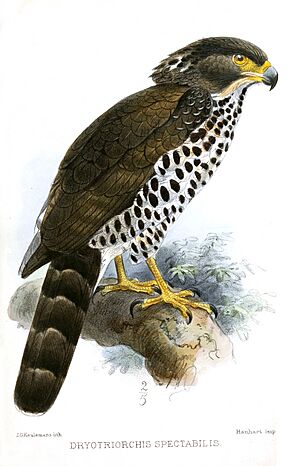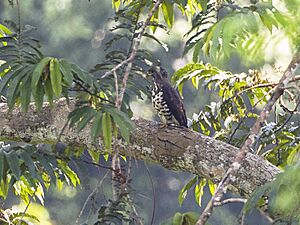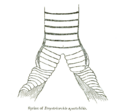Congo serpent eagle facts for kids
Quick facts for kids Congo serpent eagle |
|
|---|---|
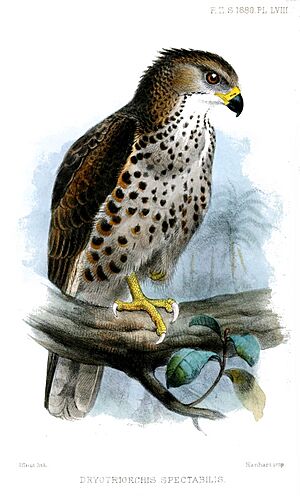 |
|
| Conservation status | |
| Scientific classification | |
| Genus: |
Dryotriorchis
|
| Species: |
spectabilis
|
| Subspecies | |
|
|
 |
|
| The distribution of the Congo serpent eagle (orange) | |
| Synonyms | |
|
|
The Congo serpent eagle (Dryotriorchis spectabilis) is a cool bird of prey found in the African rainforest. It's the only member of its special group, or monotypic genus, called Dryotriorchis. This eagle loves to hunt in the dark, shadowy parts of the forest.
There are two types, or subspecies, of this eagle: Dryotriorchis spectabilis spectabilis and Dryotriorchis spectabilis batesi. This medium-sized bird has short, rounded wings and a long tail. It's mostly brown on its back and has a small crest on its head. Its chest is white, sometimes with a reddish tint. The first subspecies has black spots on its chest, while the second only has them on its sides.
The Congo serpent eagle looks a lot like another bird, Cassin's hawk-eagle. Some scientists think this is a rare example of mimicry, where one animal copies another's look. This eagle is also very noisy! You can often hear its calls in the forest. It eats snakes, chameleons, and toads. It's listed as a species of Least Concern because there are many of them, and they live in a wide area.
Contents
What is the Congo Serpent Eagle?
The Congo serpent eagle is a type of bird of prey in the Accipitridae family. It was first described in 1863 by Hermann Schlegel. He first thought it was a type of goshawk. Later, in 1874, George Ernest Shelley realized it was unique. He gave it its own special group, or genus, called Dryotriorchis.
The name "Dryotriorchis" comes from Greek words. "Dryo-" means "oak," and "triorchis" means "hawk." This hawk is special because of its short wings, long tail, small crest, and oval-shaped nostrils. Scientists believe it's closely related to the Circaetus genus.
Subspecies of the Congo Serpent Eagle
There are two known subspecies of the Congo serpent eagle. The first is the Dryotriorchis spectabilis spectabilis. The second is D. s. batesi. This second subspecies was first thought to be a separate species. Richard Bowdler Sharpe described it in 1904. He named it after George Latimer Bates, who sent him specimens from Cameroon. The D. s. batesi subspecies has fewer spots on its chest.
Why Does the Congo Serpent Eagle Look Like Another Bird?
The Congo serpent eagle looks very similar to Cassin's hawk-eagle. Both birds live in the same areas. Scientists think the Congo serpent eagle might mimic the hawk-eagle. This could help it in several ways. It might trick its prey, like reptiles, into not running away. It could also protect itself from other predators. Or it might stop other birds from mobbing it, as they would a bird-eating hawk.
The D. s. spectabilis subspecies looks like a young Cassin's hawk-eagle. The D. s. batesi subspecies looks like an adult. This is one of the very few times scientists think birds might be mimicking each other.
Physical Appearance of the Congo Serpent Eagle
This hawk is a medium-sized bird. It is slender and has short, rounded wings. Its tail is long and rounded. It measures about 54 to 60 centimeters (21 to 24 inches) long. Its tail alone is about 24.5 to 26.8 centimeters (9.6 to 10.6 inches) long. The wingspan of this eagle is about 94 to 106 centimeters (37 to 42 inches).
The adult Dryotriorchis spectabilis spectabilis has a dark brown head and upper neck. The sides of its neck and a wide collar are a reddish-brown. The feathers on its head are a bit spiky, giving it a small crest. The rest of its upper body is dark chocolate brown. Its cheeks are light brown, and its throat is a creamy white with stripes.
Its eyes are large. Females have dark brown or grey eyes, while males have yellow eyes. The beak is short but strong. The bird's belly is white, often with some reddish color. It also has many large, round blackish spots. Its thighs have brown and white stripes. The underside of its tail is white. The tail itself is light brown with five or six wide black stripes. Its claws are short and sharp, and its legs are yellow.
Male and female eagles look similar. However, females are usually about three percent larger than males. Young eagles have a white head and back. They have round brown or black spots on their upper back. These spots disappear as the bird gets older. Their wings and tail are greyish-brown and lighter than adults'. They also have darker stripes.
Differences Between Subspecies
The D. s. batesi subspecies looks similar to the other one. But it is browner and lighter on its back. The spots that are on the chest of D. s. spectabilis are only found on the sides of D. s. batesi. Young D. s. batesi birds do have spotted chests, but these spots also fade as they grow up.
What Does the Congo Serpent Eagle Sound Like?
This eagle is a very vocal bird of prey. It is one of the most common sounds you will hear in its habitat. It makes a sound like a cat meowing. It also makes a low, sad, nasal "cow-cow-cow" sound. It repeats this sound for a long time. When heard from far away, some bird experts say its call sounds like a turaco.
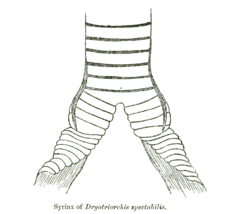
Where Does the Congo Serpent Eagle Live?
The Congo serpent eagle lives in parts of West and Central Africa. You can find it in southern Sierra Leone, Guinea, Liberia, and southern Côte d'Ivoire and Ghana. It also lives in southern Nigeria and the Central African Republic. Its range extends south through the northern and eastern Democratic Republic of the Congo. It also lives through Gabon into the northern Republic of the Congo. There's even a small group living in northern Angola.
The D. s. spectabilis subspecies lives in the upper Guinean forests. This area stretches from Liberia to northern Cameroon. The D. s. batesi subspecies lives in the lower Guinean forests. This area goes from southern Cameroon through Gabon and into western Uganda. The total area where this eagle lives is about 2,880,000 square kilometers (1,110,000 square miles).
This eagle prefers to live in dense, untouched forests. It stays in the dark, lower parts of the forest, usually below 900 meters (3,000 feet) in height. It is not well-suited for forests that have been cut down or for plantations. The Congo serpent eagle does not migrate. However, scientists are not sure if it moves around locally within its habitat.
Life and Habits of the Congo Serpent Eagle
Not much is known about how this eagle behaves. The Congo serpent eagle spends its time in the lower parts of the forest. Sometimes, it will perch on lower branches of tall trees. It lives either alone or in pairs.
What Does the Congo Serpent Eagle Eat?
This species is known to hunt and eat snakes, lizards (especially chameleons), and toads. It might also eat small mammals. It hunts by dropping to the ground from its perch. Once it catches its prey, it might hit it many times with its feet. This eagle can also grab prey from the leaves while hunting.
Its large eyes help it hunt even when there is not much light. It hunts during the day. Studies on its eyes show that they can see about twice as clearly as human eyes.
Reproduction and Breeding Habits
Very little is known about the breeding habits of the Congo serpent eagle. It is thought to breed from October to December in Gabon. In the Democratic Republic of the Congo, it might breed from June to November.
Congo Serpent Eagle and Humans
The number of Congo serpent eagles is decreasing. This is mainly because of deforestation, which means forests are being cut down. However, this eagle is still listed as a species of Least Concern. This is because it has a large population of over 10,000 adult birds. It also lives in a very large area, about 2,880,000 square kilometers (1,110,000 square miles).
This species has been kept as a pet before. In the 1970s, you could even buy them from some pet shops. The Congo serpent eagle has also appeared on postage stamps from the Democratic Republic of the Congo and Tanzania.
Images for kids



